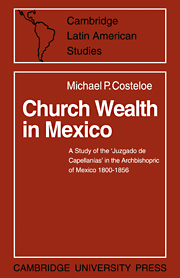 Church Wealth in Mexico
Church Wealth in Mexico Book contents
- Frontmatter
- Contents
- Acknowledgements
- Preface
- Abbreviations
- Introduction
- 1 The Juzgado de Capellanías. Organization and employees
- 2 The Juzgado and its revenue
- 3 Personal loans from the Juzgado
- 4 The effects of clerical investment
- 5 The Juzgado and the State
- Conclusion
- List of sources and works cited
- Index
3 - Personal loans from the Juzgado
Published online by Cambridge University Press: 27 March 2010
- Frontmatter
- Contents
- Acknowledgements
- Preface
- Abbreviations
- Introduction
- 1 The Juzgado de Capellanías. Organization and employees
- 2 The Juzgado and its revenue
- 3 Personal loans from the Juzgado
- 4 The effects of clerical investment
- 5 The Juzgado and the State
- Conclusion
- List of sources and works cited
- Index
Summary
The person who established a capellanía did so in the hope and expectation that it would endure perpetually, for the purpose of the benefice was that the principal would provide an income to enable a cleric to say a stipulated number of masses each year for the soul of the founder. Although the capellanía would die, the monetary fund providing the income would endure, and, therefore, a succession of capellanes would continue in perpetuity to pray for their benefactor. The pious works were likewise intended to provide a continuous source of income with which to carry out the desired charity. As the Church was the only institution which could be considered honest, permanent and perpetual, the trusteeship of these foundations was inevitably given to it, and within the Church the Juzgado was the specific organization charged with the management of the finances involved. Therefore, the nature of the revenue which the Juzgado received caused it to act as a type of investment company or bank.
The other ecclesiastical corporations, notably the convents, also received large sums in the form of legacies and other sources of revenue, for example, alms and dowries yielded considerable amounts, particularly in the colonial period. One of the ways chosen by the convents for utilizing their surplus income and for safeguarding their future needs was investment at interest.
The method adopted by the Juzgado for safely investing the capital and acquiring the necessary interest on it was to extend loans at interest to any person who could offer sufficient security to guarantee the loan.
- Type
- Chapter
- Information
- Church Wealth in MexicoA Study of the 'Juzgado de Capellanias' in the Archbishopric of Mexico 1800–1856, pp. 66 - 85Publisher: Cambridge University PressPrint publication year: 1967


